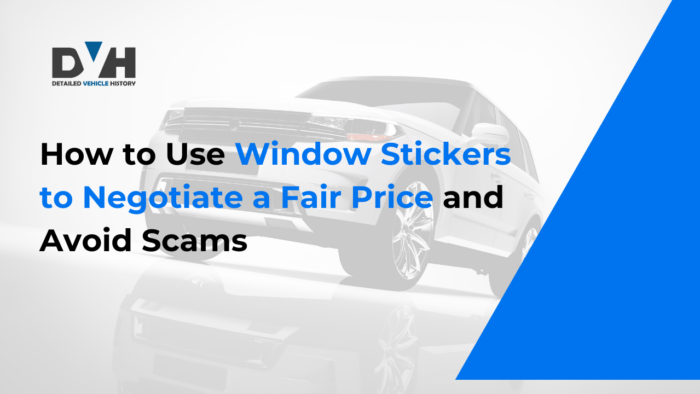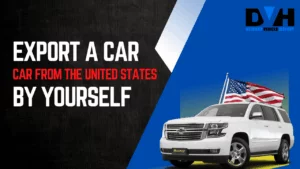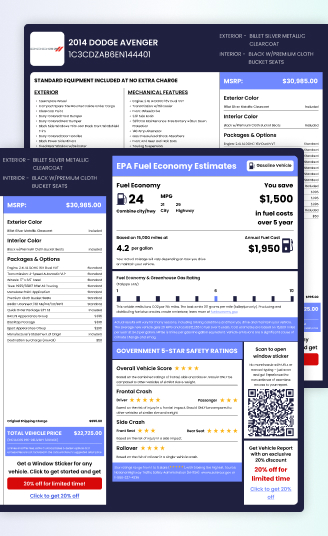Are you buying a used car? Scared of falling into scams? It’s actually normal for car buyers to feel this way. You must understand that when it comes to buying or selling a car, having the right information at your fingertips is crucial, and window stickers, those labels you often find on car windows, can be a very good tool if you want to ensure a fair deal. Whether you’re buying a vehicle online or walking into a used car dealership, you need to be extremely cautious. In this guide, we’ll show you how to use window stickers effectively to get a perfect deal.
The Role of Window Stickers in The Buying-Selling Process
Window stickers play a pivotal role in helping both buyers and sellers make well-informed decisions when it comes to purchasing or selling a vehicle. For buyers, these stickers provide a wealth of information about a car’s specifications, features, pricing, and more. This transparency empowers buyers to assess the value of a vehicle accurately and negotiate a fair price.
On the other hand, for sellers, window stickers serve as a means to showcase a car’s attributes and establish trust with potential buyers. Accurate and complete window stickers can attract serious buyers and expedite the sales process. Overall, these stickers act as a bridge of transparency, fostering confidence and facilitating smoother transactions in the automotive market.
Now, let’s get to business and discover how to use window stickers to negotiate a fair price and avoid scams
How To Avoid Car-Buying Scams with Window Stickers By VIN
When it comes to buying a used or new vehicle, you just need to be extremely careful, especially if this is your first time buying a car. Here are some of the steps to follow to avoid fraudsters.
Step 1: Researching The Price
When it comes to buying a car, one of the first steps towards a successful transaction is understanding the vehicle’s market value. This knowledge is essential for both buyers and sellers, as it forms the foundation for negotiations and ensures that the transaction is fair for all parties involved.
One effective way to determine a car’s market value is by utilizing the original sticker by VIN. This sticker, often referred to as the window sticker, provides a comprehensive overview of the vehicle, including its manufacturer’s suggested retail price (MSRP) when it was first sold. By inputting the VIN into specialized online tools like Detailed Vehicle History, you can easily access the original window sticker. This document not only reveals the initial price but also lists the vehicle’s features, options, and specifications. Armed with this information, you can assess whether the current asking price aligns with the car’s market value. Buyers can use this information to make informed offers, while sellers can justify their asking price based on the vehicle’s specifications and the prevailing market conditions.
Step 2: Checking for Hidden Fees and Charges
Before committing to that purchase, you need to find out if there are hidden fees and charges. These fees can quickly turn what seems like a good deal into a financial headache. They can include documentation fees, dealer preparation fees, delivery charges, and more. Have you heard of “Bump Stickers?” They are stickers attached to cars for sale to mimic the look of a window sticker. These scammers go ahead to include additional charges for this piece of paper and unsuspecting customers fall for it..
By identifying and understanding these additional costs upfront, you can budget more effectively and negotiate with confidence. With an idea of the sticker price, you can easily identify when the charges are going overboard. Knowledge from the window sticker will not only help you budget more effectively but also enable you to negotiate a fair and transparent deal, ensuring a smoother and more satisfying car-buying experience. Don’t be tricked into paying for unnecessary packages and fees. Verify the car’s market value and expose hidden fees before payment.
Step 3: Verifying Features and Options
Verifying a vehicle’s features and options by VIN is essential for informed decision-making in the car buying or selling process. It enables you to assess the vehicle’s suitability, evaluate its value, and negotiate confidently. The window sticker serves as a comprehensive resource to verify these crucial details.
Here’s how to use it effectively:
- Access the Window Sticker: Locate the window sticker on the car or obtain it online using the VIN.
- Explore Features and Options: Review the sticker to identify the vehicle’s features and options.
- Match with Your Requirements: Compare the listed features with your preferences.
- Seek Clarification: Don’t hesitate to ask the seller for more information if needed.
By following these steps, you can verify a car’s features and options accurately, ensuring that your purchase aligns with your needs and budget.
Step 4: Identifying Potential Issues and Recalls
When buying a car, ensuring that it’s free from potential issues and recalls is paramount to a worry-free ownership experience. Knowing a car’s recall history can save you from future headaches and unexpected expenses. Uncovering potential issues or recalls is essential because:
- Safety Comes First: Recalls often address safety-related concerns. Knowing if a car has been subject to a recall helps you ensure the safety of yourself and your passengers.
- Financial Peace of Mind: Identifying and addressing existing issues before purchase can prevent costly repairs down the road. It can also give you leverage in negotiations.
Buying a used vehicle with open recalls may imply that the vehicle is not safe to drive until fixed by the manufacturer. You really don’t want to be caught up with a vehicle in such a condition and this is why you have to check for recalls before purchase.
You cannot get recall information through the window sticker but this piece of information is one to remember during any car purchase. Check for recalls with a VIN Check tool today.
Beware of Scams: Tips to Avoid Common Car Scams
While window stickers are a valuable resource, scammers have found ways to exploit them. Be cautious of fake or altered window stickers. If something doesn’t look right or if the deal seems too good to be true, proceed with caution. Always verify the authenticity of the sticker and the information it contains. To protect yourself from falling victim to deceitful practices, here are some valuable tips:
- Verify the Window Sticker: Always cross-reference the information on the window sticker with the details provided by the seller. Discrepancies may signal a scam.
- Trust but Verify: Don’t solely rely on a seller’s word; independently verify information about the car’s history and condition through sources like vehicle history reports.
- Beware of Too-Good-to-Be-True Deals: If a deal seems exceptionally good, exercise caution. Scammers often use tempting offers to lure in unsuspecting buyers.
- Insist on an In-Person Inspection: Whenever possible, inspect the car in person before committing to a purchase. Avoid deals that only allow for remote transactions.
- Use Secure Payment Methods: If you’re buying a car, use secure payment methods such as escrow services or bank transfers. Avoid cash transactions, as they can be risky.
- Be Skeptical of Altered Stickers: Scrutinize window stickers for signs of tampering or alterations, as some scammers may attempt to modify them to misrepresent a vehicle’s features or history.
- Get a Vehicle History Report: Obtain a comprehensive vehicle history report to check for any hidden issues or accidents. Services like Detailed Vehicle History can provide this valuable information.
- Don’t Rush: Take your time during the buying process. Scammers often pressure buyers to act quickly. Be patient and thorough in your research.
- Trust Your Instincts: If something doesn’t feel right or if a deal seems suspicious, trust your instincts and consider walking away.
- Use Reputable Platforms: When buying or selling, use well-known and reputable platforms, both online and in-person. Avoid deals that only occur through obscure or unverified channels.
By following these tips, you can significantly reduce the risk of falling victim to common scams in the car-buying or selling process. Stay vigilant, do your research, and make informed decisions to ensure a safe and secure transaction. You can also explore our detailed window sticker by VIN guide and learn all you need to know about window stickers.









